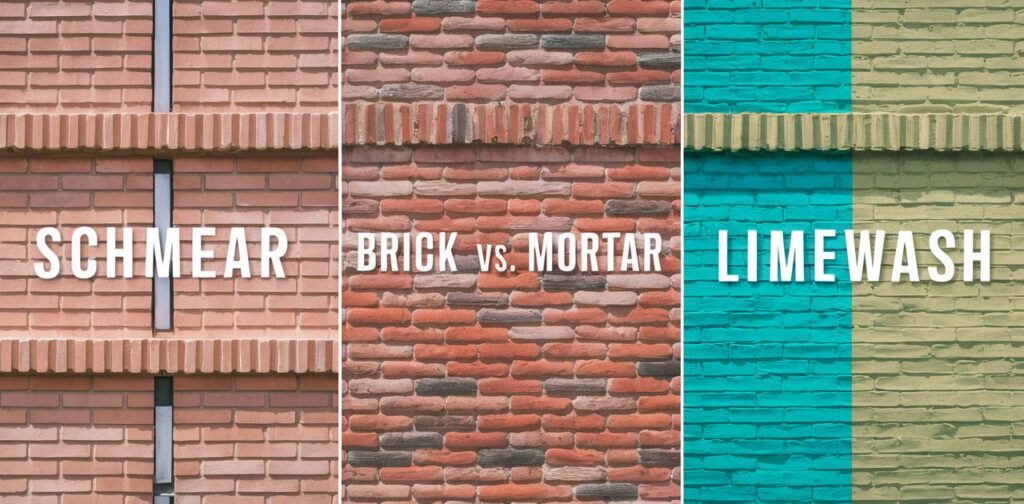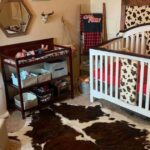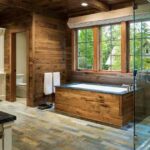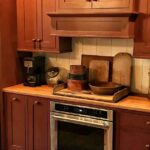Ever noticed those charming old-world houses with their beautifully aged brick exteriors? Chances are, you’re looking at German schmear, mortar wash, or limewash. But what’s the difference?
German schmear is a technique where wet mortar is smeared over bricks, creating a rustic, textured look.
Mortar wash? That’s just another name for German schmear.
Limewash, on the other hand, uses a mixture of crushed limestone and water to create a softer, more muted finish.
All three methods add character to brick surfaces, but each has its own unique charm. Whether you’re renovating or just curious, understanding these techniques can help you appreciate the artistry behind those stunning brick facades.
What Is German Schmear/German Smear or Mortar Wash?
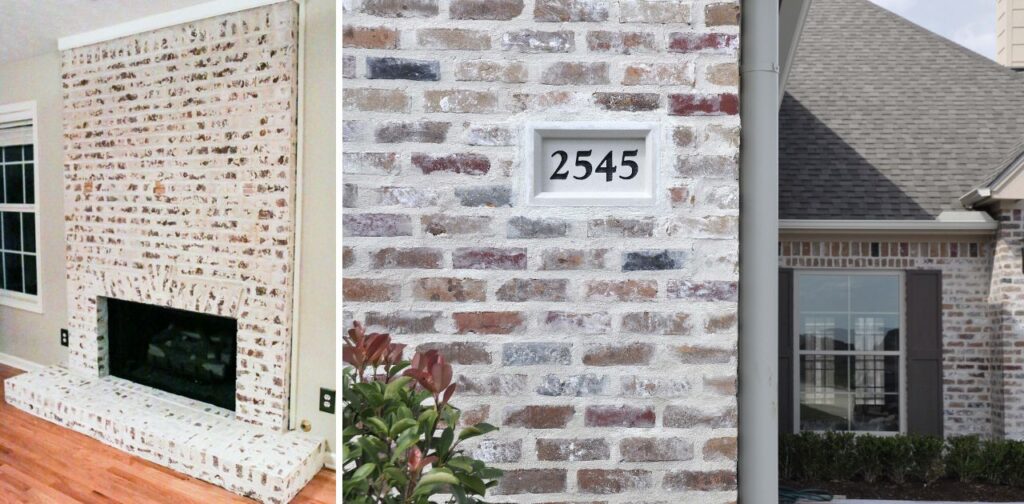
Picture this: You’re strolling through a quaint German village, admiring the centuries-old buildings. That distinctive, aged look on the brick walls? That’s German schmear (or “smear” if you prefer the English spelling). But what exactly is it?
German schmear is a brick finishing technique that involves smearing wet mortar over brick or stone surfaces. It’s not just about slapping on some mortar and calling it a day. The process requires skill and artistry to achieve that perfect balance of coverage and exposed brick.
Why Do People Use German Schmear on Their Houses Today?
You might be wondering, “Why go through all this trouble when I could just paint my bricks?” Well, German schmear offers a unique aesthetic that paint simply can’t match. Here’s why it’s gaining popularity:
- Old-world charm: It gives new homes a sense of history and character.
- Texture and depth: The irregular application creates visual interest.
- Customizable coverage: You can choose how much brick to leave exposed.
- Durability: It’s more than just a pretty face – it offers protection too.
Many homeowners are drawn to German schmear because it fits well with popular styles like farmhouse, craftsman, and even industrial. It’s a way to add warmth and personality to what might otherwise be a plain brick facade.
How to Do German Schmear on a Brick House
Thinking of trying German schmear on your own home? Here’s a quick rundown of the process:
- Wet the bricks: This helps the mortar adhere better.
- Mix the mortar: Aim for a consistency similar to thick paint.
- Apply the mortar: Use a trowel to smear it onto the bricks.
- Wipe selectively: Remove some mortar to expose parts of the brick.
- Let it dry: Allow the mortar to cure fully.
Sound simple? It can be, but achieving that perfect, effortless-looking finish takes practice. Many homeowners opt to hire professionals for the best results.
What Are the Pros and Cons of German Schmear on Brick?
Like any home improvement technique, German schmear has its upsides and downsides. Let’s break them down:
Advantages of German Schmear/Mortar Wash
- Unique aesthetic: Each application is one-of-a-kind.
- Durability: It can last for decades with minimal maintenance.
- Weather protection: Adds an extra layer of defense against the elements.
- Versatility: Works well on both exterior and interior brick.
- Breathability: Allows moisture to escape, preventing damage to the brick.
Disadvantages of German Schmear/Mortar Wash
- Permanence: Once applied, it’s extremely difficult to remove.
- Time-consuming: Proper application takes skill and patience.
- Limited color options: Typically restricted to white or light gray.
- Potential for mess: It can be a messy process during application.
How Long Does German Schmear Last?
One of the biggest selling points of German schmear is its longevity. When done correctly, it can last for decades – sometimes even outlasting the original mortar in the brickwork! Unlike paint, which may need touching up every few years, German schmear ages gracefully. Many homeowners find that they love the look even more as it weathers over time.
What Is Limewash for Brick?

Now, let’s shift gears and talk about limewash. If German schmear is the hearty stew of brick finishes, limewash is more like a delicate soup. But what exactly is it?
Limewash is a type of surface treatment made from crushed limestone that’s been mixed with water to create a milky solution. It’s been used for centuries to protect and beautify buildings, and it’s making a comeback in modern home design.
Also, read this interesting blog:
My Earth Breeze Review: Can These Laundry Detergent Sheets Stand Up To The Test?
What Is the Difference Between German Smear vs. Limewash?
While German schmear and limewash might look similar at first glance, they’re quite different:
- Material: German schmear uses mortar, while limewash is made from limestone.
- Application: Limewash is painted on, while German schmear is troweled on.
- Texture: Limewash has a smoother finish compared to the chunkier German schmear.
- Permanence: Limewash is more easily removable in the first 5 days after application.
How to Limewash Brick
Curious about trying limewash on your own brick surface? Here’s a quick guide:
- Clean the brick thoroughly.
- Wet the surface.
- Apply the limewash with a large brush.
- Let it dry for about 30 minutes.
- Spray lightly with water and brush off excess for a distressed look (optional).
- Repeat for additional coats if desired.
Remember, the key to a good limewash is patience and even application. It’s not a race – take your time and enjoy the process!
What Are the Pros and Cons of Limewash on Brick?
Limewash Advantages
- Natural and eco-friendly: Made from non-toxic materials.
- Breathable: Allows moisture to escape from the brick.
- Antimicrobial: Naturally resists mold and mildew growth.
- Customizable: Can be tinted to various soft, muted colors.
- Aged look: Develops a beautiful patina over time.
Limewash Disadvantages
- Less durable than German schmear: May need reapplication every 5-7 years.
- Weather dependent: Application requires specific conditions.
- Variable results: Final look can be unpredictable.
- Chalky texture: Some people find the finish too powdery.
How Long Does Limewash Last?
Limewash typically lasts about 5-7 years on exterior surfaces before needing a refresh. However, on interior walls or in protected areas, it can last much longer. The good news? Reapplying limewash is relatively easy and inexpensive compared to other finishing techniques.
What Is Whitewash for a Brick House?
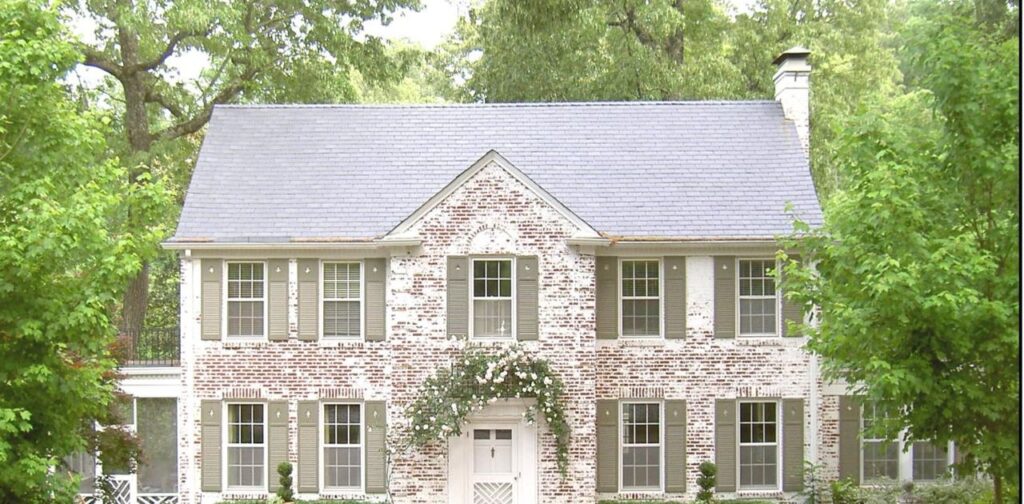
You’ve probably heard the term “whitewashed” before, but what does it really mean when it comes to brick? Whitewash is essentially a very thin paint made by mixing water and white paint. It’s been used for centuries to brighten up buildings and protect surfaces.
What Is the Difference Between German Schmear vs. Whitewash?
While both techniques can give your brick a lighter, aged appearance, they’re quite different:
- Material: Whitewash uses paint, while German schmear uses mortar.
- Coverage: Whitewash is more translucent, allowing more of the brick to show through.
- Texture: Whitewash creates a smoother finish compared to the textured German schmear.
- Application: Whitewash is brushed or rolled on, while German schmear is troweled.
How to Whitewash Brick
Want to try whitewashing your brick? Here’s a simple guide:
- Clean the brick surface thoroughly.
- Mix white latex paint with water (1:1 ratio is a good starting point).
- Apply the mixture with a brush or roller.
- Wipe off excess with a rag for a more distressed look.
- Let it dry and assess if you need another coat.
Remember, you can adjust the paint-to-water ratio to achieve your desired level of opacity.
Pros and Cons of Whitewash
Advantages of Whitewash on Brick
- Affordable: One of the least expensive brick finishing options.
- Easy to apply: Can be a DIY project for many homeowners.
- Customizable: Can be made thinner or thicker for different effects.
- Removable: Easier to remove than German schmear or limewash.
- Quick results: Transforms the look of brick in just a few hours.
Disadvantages of Whitewash on Brick
- Less durable: May need touch-ups more frequently than other methods.
- Limited protection: Doesn’t offer as much weather protection as mortar-based finishes.
- Potential for peeling: If not applied correctly, it can flake off over time.
- Less texture: Doesn’t add the same depth as German schmear or limewash.
How Long Does Whitewash Last?
Whitewash typically lasts about 3-5 years on exterior surfaces before needing a refresh. However, this can vary depending on the quality of application, the type of brick, and environmental factors. Indoor whitewashed brick can last much longer with proper care.
A Brief Overview of Other Brick Finishing Methods
While we’ve covered the most popular brick finishing techniques, there are a few other methods worth mentioning:
Staining Brick
Brick staining is a process that changes the color of your brick without altering its texture. It’s like dyeing fabric – the color penetrates the brick, creating a permanent change.
Advantages and Disadvantages of Staining Brick
Pros of Brick Staining:
- Preserves brick texture
- Wide range of color options
- Long-lasting results
- Low maintenance
Cons of Brick Staining:
- Difficult to reverse
- Requires professional application for best results
- Can be expensive compared to painting
Painting Brick
Painting brick is perhaps the most straightforward way to change its appearance. It involves applying exterior paint directly to the brick surface.
Pros of Painting Brick:
- Unlimited color options
- Can hide imperfections in the brick
- Relatively easy to apply
Cons of Painting Brick:
- Can trap moisture if not done correctly
- Requires regular maintenance and repainting
- Difficult to remove and return to natural brick
Leave Your Brick “As Is”
Sometimes, the best finish is no finish at all. Natural brick has its own charm and requires very little maintenance.
Pros of Natural Brick:
- Low maintenance
- Timeless appeal
- No risk of peeling or chipping
Cons of Natural Brick:
- Limited color options
- Can’t hide imperfections or damage
- May look too “plain” for some homeowners’ tastes
Final Words
Brick finishing techniques like German schmear, mortar wash, and limewash can transform your home’s look. German schmear uses mortar for a rustic, textured finish that lasts decades. Limewash, made from limestone, offers a softer, more breathable option that ages beautifully. Whitewash, a simple paint-water mix, provides an easy, affordable facelift. Each method has its pros and cons, from durability to ease of application. Whether you’re after old-world charm or a fresh update, these techniques offer unique ways to personalize your brick surfaces. Remember, proper application is key to achieving the best results and longevity.
Ready to Build a German Schmear House or Any Other Type of Specialty Brick Finish on Your New Dream Home?
After exploring all these brick finishing techniques, you might be feeling inspired to try one on your own home. Whether you’re drawn to the old-world charm of German schmear, the soft glow of limewash, or the crisp look of whitewash, there’s a brick finishing technique out there for every style and preference.
Remember, while some of these techniques can be DIY projects, others are best left to professionals. Don’t be afraid to consult with experts or ask for samples before committing to a full-scale project. After all, your home is a big investment, and you want to make sure you’re happy with the results for years to come.
So, what’s your favorite brick finishing technique? Are you Team German Schmear, or does the idea of a limewashed exterior make your heart skip a beat? Whatever you choose, remember that the best finish is the one that makes you smile every time you pull into your driveway.
FAQ’s
What is the difference between German Schmear and limewash?
German schmear uses mortar, creating a thicker, more textured finish that’s highly durable. Limewash, made from limestone, produces a softer, more breathable coating that develops a beautiful patina over time. German schmear is more permanent, while limewash can be easier to remove or reapply.
Is mortar wash the same as German smear?
Yes, mortar wash and German smear are the same technique. Both terms refer to the process of applying wet mortar over brick or stone to create a distressed, aged look. The technique originated in Germany, hence the name “German smear,” but it’s also commonly known as mortar wash in some regions.
What is a German Schmear on brick?
German schmear is a brick finishing technique where wet mortar is applied over brick surfaces and then partially wiped off. This creates a rustic, aged appearance reminiscent of centuries-old European buildings. It adds texture and character to brick walls while also providing an extra layer of protection against the elements.
Is German Schmear better with mortar or grout?
German schmear is typically done with mortar, not grout. Mortar is more suitable for this technique because it’s designed to adhere to brick and has the right consistency for spreading and partial removal. Grout is formulated for filling gaps between tiles and doesn’t have the same properties that make mortar ideal for German schmear.
Is it better to whitewash or limewash brick?
The choice between whitewash and limewash depends on your specific needs:
Whitewash:
- Easier to apply
- More affordable
- Offers more opacity
- May need more frequent touch-ups
Limewash:
- More durable
- Naturally mold-resistant
- Develops a beautiful patina over time
- More breathable, allowing moisture to escape
If you want a quick, easy change, whitewash might be better. For a long-lasting, natural finish that improves with age, limewash could be the better choice.
How long does German smear last on brick?
When properly applied, German smear can last for decades. It’s one of the most durable brick finishing techniques available. Unlike paint or whitewash, which may need touch-ups every few years, German smear becomes part of the brick surface. It can often outlast the original mortar in the brickwork. However, the exact lifespan can vary depending on factors like climate, quality of application, and how well the brick is maintained.
Read more home improvement-related interesting blogs
Homeowner’s Insurance In High Risk Areas
Should I Buy A House With A West Facing Garden?
Does A Smart TV Need An Aerial?

Howdy is behind this home blog, sharing personal stories, thoughts, and insights from daily life. I can dedicated to bringing you the latest trends, expert advice, and creative ideas to make your home the sanctuary you’ve always dreamed of. Whether you’re looking for DIY tips, home decor inspiration, home loans, rentals or renovations.

